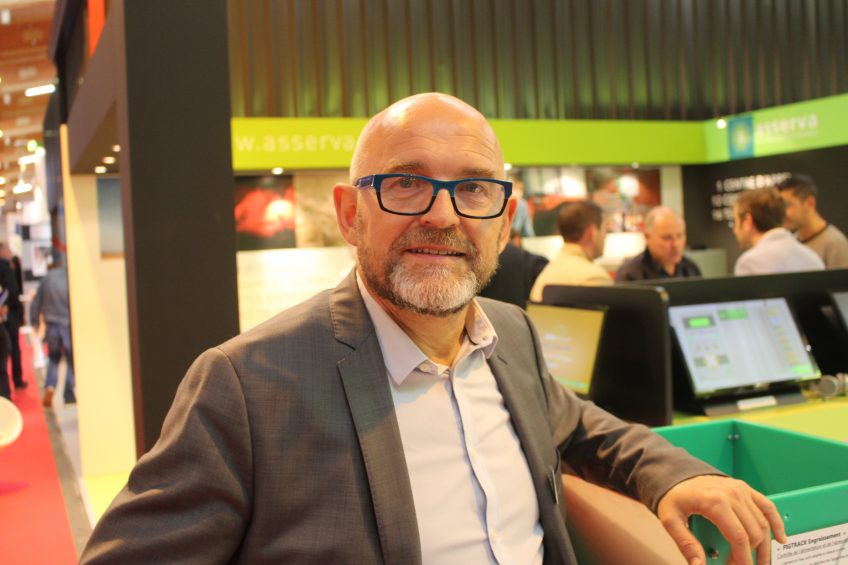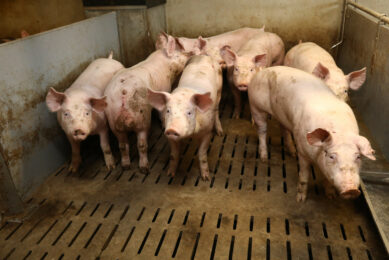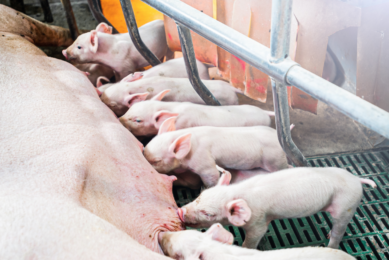Interview: Asserva’s CEO talks about total pork traceability

Imagine: when buying a piece of pork, just scanning a barcode will give all the information as to where the pig lived, what it consumed and how it was treated. Science fiction? Not at all, the future is right at our doorsteps, says Dominique Cantin, CEO of Asserva.
In theory, it has long been possible to know how each individual finisher pig performs. After all, it has been done with sows for quite a number of years now. Each animal needs to receive a Radio-Frequency Identification (RFID) tag and that way an animal’s feeding habits can be monitored and influenced. In practice, however, decisions on finisher performance are being taken mostly on batch level. Information on individual finisher pigs is hardly gathered or monitored.
Soon that all will change, believes Dominique Cantin, age 53, CEO of Asserva in France, a company specialised in the production of automatic feeding equipment. At SPACE 2017, the international trade show in Rennes, France, the company introduced a first prototype of PigTrack. This is an RFID feeding system that can monitor individual feeding and drinking consumption. Using apps, it can warn producers should animals fail to show up at the trough using colour codes, identical to a traffic-light. At the time, the company received one star for the innovation. Asserva aims to release a fully commercial version at this year’s edition of SPACE and EuroTier.
What is the company’s philosophy, what does it expect of this type of development and where will the pig industry move in the years to come according to Mr Cantin?
|
Pig Progress: What is the background behind PigTrack?
Dominique Cantin: “About 3 years ago, the media began to cover the issue of antibiotic resistance and we thought that that was the right moment to develop a solution so that this coverage would not affect the pig industry. The first idea was to reduce antibiotic consumption of pigs: how can we detect diseases sooner? The answer was to put a tag on the animals and to study their feeding habits. Because soon it will be possible to put a tag on an animal, without questions being asked about costs. Think of disposable tags, allowing full traceability of the life of the animals, from farrowing to slaughter.”
Did you develop the prototype on your own?
“Asserva is specialised in precision feeding systems; in the company we don’t have any vets or agronomic specialists. So from the beginning, we aimed to collaborate with others. We work in partnership with 3 institutes:
- the French Pork and Pig Institute (IFIP),
- the French National Institute for Agronomical Research (INRA)
- the Veterinary School of Toulouse, France.
At the moment, PigTrack sends alerts to a farmer’s phone, informing that, based on its consumption of feed and water, this pig has a problem – and he should have a look. The 3 institutes take things further, they create a ‘pig consumption’ database, to be more accurate with regard to diagnostics. The more data we have, the more accurate our diagnostics will be.”
So it is based on the consumption of feed and the consumption of water. What else?
“Time, for instance. We know how much time a pig spends eating or drinking. It’s not only the quantity of feed and the quantity of water, but also consumption habits. In addition, we use the tags to indicate if a pig received a treatment and what kind of treatment. We thus track the feed and water consumption behaviour of the pig, but also its medication profile.”
Is the pig industry ready for these types of ideas?
“Definitely – all big companies in the sector, be it slaughterhouses, technicians, feeding companies, are in this process of collecting and treating data. Chipping will provide total traceability. Not only on-farm, but also on e.g. a package of ham: with a barcode you can scan to see e.g. where the pig was raised, when it received vaccinations and whether it received antibiotics or not: this will improve the transparency between farmers and consumers. In addition, slaughterhouses can ask for specifications: for example, in summer you need to produce 60% of pigs this lean or this fat and the contrary in winter. So with these tags, farmers can adapt to requirements.”
When do you expect the market to be ready for these cheap tags?
“Currently we are in a phase of transition. Perhaps in one year, more likely in 5 or 10 years for sure. Europe will have to compete with new markets which may still allow the use of growth hormones and genetically modified organisms, for instance. If we want to compete with them, we have to work on total transparency and meat quality. Also, it will help us to have better zootechnical performances.”
More international focus and R&D
Although his father was a pig farmer, Dominique Cantin joined Asserva about 30 years ago by chance, having been educated as a pâtissier – preparing delicious French-style pastry. As a sales person, he quickly made a career and together with 2 other colleagues took over the daily management of the company in 2008 when the old bosses retired. The emphasis changed towards a more international focus and stronger R&D. One of the company’s flagship products is the Materneo, electronic feeding equipment for farrowing sows. Currently, about 80% of the company’s revenues come from the pig business, with 10% from cattle and poultry and 10% being variable from year to year.
What appealed to you to come back to work in the pig business after all?
“I just didn’t want to work at a farm, as a farmer. But as soon as I discovered livestock equipment, innovations and improving zootechnical performances – then I learnt that that was what I wanted to do. All around Asserva there are curious people: not only farmers, but also vets, technicians – curiosity is in the DNA of Asserva. When we took over the company in 2008, we agreed together that we’d always keep one foot inside the farm, so that we won’t be stuck inside the office.”
Which were your markets prior to 2008?
“This was mainly France – and we were even active in the calf sector. We had several projects in the Netherlands and in Italy, but to be honest these were one-off projects.”
How would you describe the business now?
“Export markets are growing. It’s a slow process; at the beginning you will have to find local distributors, to install and sell the products, to do after-sales. Once that is done, things grow fast. It’s now been 10 years and we have sales in China, in Belgium, Kazakhstan, Spain, Canada and eastern markets, and also we are beginning to export our products in the UK as well. The main objective is to have 30% of the turnover made in foreign markets by the end of 2019.”
What is your personal ambition for the company, where would you like to take the company beyond PigTrack?
“In terms of innovation, Asserva re-invests 8-9% of the turnover into research & development – which is a lot for a company like us. It will then be diluted into the turnover, because a lot will go to the foreign markets. The goal for the end of my career will be to be present in about 40 countries. That’s a good goal.”
The UN has published that in 2050 we will be 9 billion people. Will we be able to feed the world?
“It will be complicated. First – when we are 9 billion people on the planet, maybe not all 9 billion people will be able to afford meat. Secondly, perhaps we will eat less meat, but meat with better quality, thanks to better traceability and better taste of the meat. And of course we will have to work again and again and again on the welfare of animals. And not only work on it but also show it and communicate about it, which we don’t do at the moment.”
Somehow we’ve got to find the middle way between welfare and consumption.
“We don’t need to eat, as humans, 200g of meat at each meal. To produce 1kg of meat, we need to produce 3kg of cereals. So if you want to provide meat to 9 billion people of course we will still eat meat, but in fewer quantities. In addition, there is also the function of sharing of the meat, when we have a meal we have the opportunity to be with family. This is not only the requirements of the body, but also the social needs.”


 Profile
Profile








